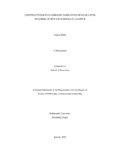
Please use this identifier to cite or link to this item:
https://hdl.handle.net/20.500.14301/536| Title: | Constructivism in Classroom: Narratives of Basic Level Teachers of Private Schools in Lalitpur.[Unpublished MPhil Disertation]. |
| Authors: | Malla, Anjana |
| Citation: | Malla, A.(2025) .Constructivism in classroom: Narratives of basic level teachers of private schools in Lalitpur. |
| Issue Date: | Jan-2025 |
| Publisher: | Kathmandu University School of Education |
| School: | SOED |
| Department: | DOEL |
| Level: | M.Phil. |
| Program: | MPhil in Educational Leadership |
| Abstract: | Through various roles and experiences, I have recognized several issues with the pedagogical approaches used in Nepalese schools to teach and learn. Most of the time, child-friendly teaching and learning methods are undervalued. Teachers are expected to set the standard, and students must follow their instructions. Recently, many schools have emerged claiming that they are providing better education opportunities, and this research is done to find the existing practices in the field of education in Nepal. The study featured a qualitative approach with an exploratory study to identify constructivism in the classroom through narratives of the teachers working in the two private schools of Lalitpur. Using a semi-structured guiding question, an individual interview session was conducted with four teachers from the private schools of Lalitpur in three to four stages. Along with collecting teachers' narratives, a focused group discussion was conducted among five students at the study schools to generate their experience in the classroom environment. The following conclusions were drawn from the data's analysis and interpretation: It was concluded that learners-friendly pedagogy was a comprehensive strategy that included several elements about the roles and duties of teachers and students. First, the classroom environment was a key element of learner-friendly constructivist teaching, where appropriate arrangements of the classroom's physical amenities were considered essential. Second, the teaching-learning activities in the constructivist classroom complemented the student-centered pedagogy, which placed more emphasis on the needs and interests of the learners in terms of their individual and sociocultural backgrounds. Third, the learner-friendly approach's main component was student motivation. In this sense, a student's motivation is defined as the inspiration and support that helps them become more involved students. The study's finding can be implied in multiple areas related to scholars and stakeholders such as students, teachers and school management. The conclusion of this study might encourage the students to discover the enjoyable part of their learning. Also, this study might motivate teachers to consider teaching pedagogy as a comprehension depiction of the learner’s lives. The study will even be helpful to the school administration in determining the learner-friendly type of teaching-learning pedagogy. |
| URI: | https://hdl.handle.net/20.500.14301/536 |
| Appears in Collections: | Dissertation |
Files in This Item:
| File | Description | Size | Format | |
|---|---|---|---|---|
| Anjana Malla.pdf | 1.86 MB | Adobe PDF |  View/Open |
Items in DSpace are protected by copyright, with all rights reserved, unless otherwise indicated.